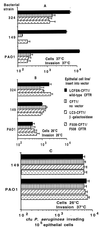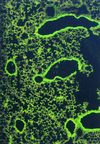Role of the cystic fibrosis transmembrane conductance regulator in innate immunity to Pseudomonas aeruginosa infections
- PMID: 10922041
- PMCID: PMC34018
- DOI: 10.1073/pnas.97.16.8822
Role of the cystic fibrosis transmembrane conductance regulator in innate immunity to Pseudomonas aeruginosa infections
Abstract
Chronic Pseudomonas aeruginosa infection occurs in 75-90% of patients with cystic fibrosis (CF). It is the foremost factor in pulmonary function decline and early mortality. A connection has been made between mutant or missing CF transmembrane conductance regulator (CFTR) in lung epithelial cell membranes and a failure in innate immunity leading to initiation of P. aeruginosa infection. Epithelial cells use CFTR as a receptor for internalization of P. aeruginosa via endocytosis and subsequent removal of bacteria from the airway. In the absence of functional CFTR, this interaction does not occur, allowing for increased bacterial loads in the lungs. Binding occurs between the outer core of the bacterial lipopolysaccharide and amino acids 108-117 in the first predicted extracellular domain of CFTR. In experimentally infected mice, inhibiting CFTR-mediated endocytosis of P. aeruginosa by inclusion in the bacterial inoculum of either free bacterial lipopolysaccharide or CFTR peptide 108-117 resulted in increased bacterial counts in the lungs. CFTR is also a receptor on gastrointestinal epithelial cells for Salmonella enterica serovar Typhi, the etiologic agent of typhoid fever. There was a significant decrease in translocation of this organism to the gastrointestinal submucosa in transgenic mice that are heterozygous carriers of a mutant DeltaF508 CFTR allele, suggesting heterozygous CFTR carriers may have increased resistance to typhoid fever. The identification of CFTR as a receptor for bacterial pathogens could underlie the biology of CF lung disease and be the basis for the heterozygote advantage for carriers of mutant alleles of CFTR.
Figures






Similar articles
-
Resistance to Pseudomonas aeruginosa chronic lung infection requires cystic fibrosis transmembrane conductance regulator-modulated interleukin-1 (IL-1) release and signaling through the IL-1 receptor.Infect Immun. 2007 Apr;75(4):1598-608. doi: 10.1128/IAI.01980-06. Epub 2007 Feb 5. Infect Immun. 2007. PMID: 17283089 Free PMC article.
-
Transgenic cystic fibrosis mice exhibit reduced early clearance of Pseudomonas aeruginosa from the respiratory tract.J Immunol. 2001 Jun 15;166(12):7410-8. doi: 10.4049/jimmunol.166.12.7410. J Immunol. 2001. PMID: 11390493
-
How mutant CFTR may contribute to Pseudomonas aeruginosa infection in cystic fibrosis.Am J Respir Crit Care Med. 1996 Oct;154(4 Pt 2):S175-82. doi: 10.1164/ajrccm/154.4_Pt_2.S175. Am J Respir Crit Care Med. 1996. PMID: 8876538
-
Mouse models of chronic lung infection with Pseudomonas aeruginosa: models for the study of cystic fibrosis.Pediatr Pulmonol. 2000 Nov;30(5):413-24. doi: 10.1002/1099-0496(200011)30:5<413::aid-ppul8>3.0.co;2-9. Pediatr Pulmonol. 2000. PMID: 11064433 Review.
-
Harnessing Neutrophil Survival Mechanisms during Chronic Infection by Pseudomonas aeruginosa: Novel Therapeutic Targets to Dampen Inflammation in Cystic Fibrosis.Front Cell Infect Microbiol. 2017 Jun 30;7:243. doi: 10.3389/fcimb.2017.00243. eCollection 2017. Front Cell Infect Microbiol. 2017. PMID: 28713772 Free PMC article. Review.
Cited by
-
Cystic fibrosis transmembrane conductance regulator and pseudomonas.Am J Respir Crit Care Med. 2014 Apr 1;189(7):763-5. doi: 10.1164/rccm.201402-0209ED. Am J Respir Crit Care Med. 2014. PMID: 24684355 Free PMC article. No abstract available.
-
Partial Restoration of CFTR Function in cftr-Null Mice following Targeted Cell Replacement Therapy.Mol Ther. 2017 Mar 1;25(3):654-665. doi: 10.1016/j.ymthe.2016.11.018. Epub 2017 Feb 8. Mol Ther. 2017. PMID: 28187947 Free PMC article.
-
Evidence for intracellular Pseudomonas aeruginosa.J Bacteriol. 2024 May 23;206(5):e0010924. doi: 10.1128/jb.00109-24. Epub 2024 Apr 10. J Bacteriol. 2024. PMID: 38597609 Free PMC article. Review.
-
Non-typeable Haemophilus influenzae invasion and persistence in the human respiratory tract.Front Cell Infect Microbiol. 2011 Nov 18;1:1. doi: 10.3389/fcimb.2011.00001. eCollection 2011. Front Cell Infect Microbiol. 2011. PMID: 22919570 Free PMC article. Review.
-
A haplotype framework for cystic fibrosis mutations in Iran.J Mol Diagn. 2006 Feb;8(1):119-27. doi: 10.2353/jmoldx.2006.050063. J Mol Diagn. 2006. PMID: 16436643 Free PMC article.
References
Publication types
MeSH terms
Substances
Grants and funding
LinkOut - more resources
Full Text Sources
Other Literature Sources
Medical

